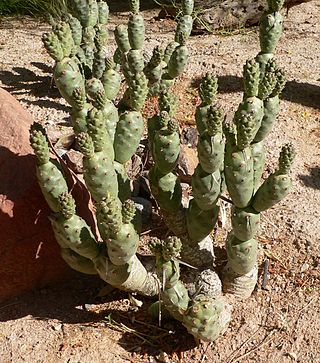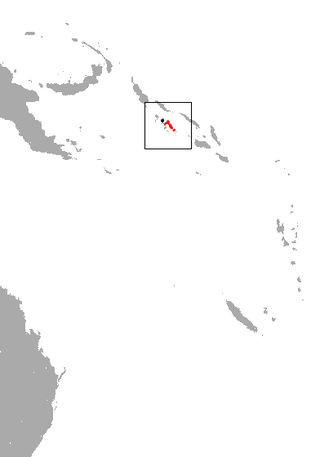
The conservation status of a group of organisms indicates whether the group still exists and how likely the group is to become extinct in the near future. Many factors are taken into account when assessing conservation status: not simply the number of individuals remaining, but the overall increase or decrease in the population over time, breeding success rates, and known threats. Various systems of conservation status exist and are in use at international, multi-country, national and local levels as well as for consumer use.

Tephrocactus is a genus of the cactus family (Cactaceae).

A genet is a member of the genus Genetta, which consists of 17 species of small African carnivorans. The common genet is the only genet present in Europe and occurs in the Iberian Peninsula, Italy and France.

Van Gelder's bat or Van Gelder's big-eared bat is a species of vesper bat in the family Vespertilionidae. It is found in Belize, Costa Rica, Honduras, and Mexico. The species is monotypic within its genus. It is part of the tribe Antrozoini within the subfamily Vespertilioninae and is related to the pallid bat. The bat is found in forest habitat from sea level to elevations as high as 2300 m, although not usually above 1300 m, and is insectivorous and crepuscular. It apparently has a fragmented distribution, and is threatened by deforestation.

The Burmese whiskered myotis or Burmese whiskered bat is a species of vesper bat. It is found in China, India, Myanmar, Laos, and Vietnam.
The long-headed hill rat is a species of rodent in the family Muridae. It is found only in Sulawesi, Indonesia, where it is only known from Mount Tambusisi. Its natural habitat is subtropical or tropical dry forests. It is threatened by habitat loss.

Goldman's woodrat is a rodent species in the family Cricetidae. It is found only in Mexico throughout the Mexican Plateau, stretching from southeastern Chihuahua to southern San Luis Potosí and northern Querétaro. The plateau is an average 5,988 ft. above sea level and covers a land area of 232,388 sq. miles.
The gray-tailed narrow-headed rat is a species of rodent in the family Muridae. It is found only in Ethiopia. Its natural habitats are subtropical or tropical moist montane forests, subtropical or tropical high-elevation shrubland, and subtropical or tropical high-elevation grassland. It is threatened by habitat loss.

Villa's gray shrew is a shrew native to northeastern Mexico, where it is called musaraña.

The giant scops owl, lesser eagle-owl or the Mindanao eagle-owl, is a species of owl in the family Strigidae. It is endemic to the Philippines. In size and structure, it is considered intermediate between a scops owl and an eagle-owl. Its natural habitat is tropical moist lowland forests. It is threatened by habitat loss.
The Bougainville crow is a species of bird in the crow family, Corvidae.

Sclater's shrew is a species of mammal in the family Soricidae. It is endemic to Mexico.

The ashy-headed flying fox or North Moluccan flying fox is a species of bat in the family Pteropodidae. It is endemic to Indonesia.

The Guinean horseshoe bat is a species of bat in the family Rhinolophidae. It is found in Ivory Coast, Guinea, Liberia, Senegal, and Sierra Leone. Its natural habitats are subtropical and tropical forests, moist savanna, caves, and other subterranean habitats.

The New Georgian monkey-faced bat or New Georgian flying monkey is a recently described species of megabat endemic to the New Georgia and Vangunu Islands. It is presumably extinct on Kolombangara Island, and the remaining populations on other islands are threatened by habitat loss and hunting. Consequently, it is considered vulnerable by the IUCN. In 2013, Bat Conservation International listed this species as one of the 35 species of its worldwide priority list of conservation.
Bat Conservation International (BCI) is an international nongovernmental organization working to conserve bats and their habitats through conservation, education, and research efforts.

The wildlife of Pakistan comprises a diverse flora and fauna in a wide range of habitats from sea level to high elevation areas in the mountains, including 195 mammal, 668 bird species and more than 5000 species of Invertebrates. This diverse composition of the country's fauna is associated with its location in the transitional zone between two major zoogeographical regions, the Palearctic, and the Oriental. The northern regions of Pakistan, which include Khyber Pakhtunkhwa and Gilgit Baltistan include portions of two biodiversity hotspot, Mountains of Central Asia and Himalayas.














